How to Create Effective Survey Questions


Being able to create effective survey questions is more valuable than you might think.
If you nail this part, you'll be able to:
- Engage target audience
- Improve the quality of the survey data
- Get more accurate responses
- Gain actionable insights
Let's upgrade your surveys to the next level!
Online Surveys – Expected Benefits
Knowing your customers and their needs and measuring customer experience is absolutely critical to business success.
Every business owner wants to know what their customers think about them and their services. Luckily, this valuable knowledge can be gathered with well-put-together online surveys.
When you're able to write great survey questions, you can truly learn what you’re doing well. Additionally, you can start fixing those areas where you have issues.
Great survey questions can also help you:
- identify trends
- get new product ideas and
- let you know how you compare against your competitors
Be Proactive, not Reactive
Unfortunately, a lot of companies aren’t getting the value out of surveys that they could. Many organizations only use surveys reactively, but not proactively.
A prime example is, when a company experiences a dip in sales and wants to find out why that is, they start surveying everyone who didn't buy after a meeting. If they had been doing this all along, they mightn't have ever experienced that dip. Simply because they would've fixed any issues right after learning about them.
Another common mistake is to simply send out as many surveys as possible in bulk and hope for the best; the best being that everyone loves you and there's nothing you should improve. This is very rarely the case.
Being proactive and having clear goals when sending surveys helps you constantly learn from your customers. This information will help you improve your product and services and help prevent customer churn.
Best Practices for Creating Effective Survey Questions
The truth is though, you need to be asking the right questions at the right time for surveys to be effective. Customers are more likely to respond and give high-quality answers when they have a closer personal relationship with you and the questions are relevant to their experience.
For example, large online retailers tend to have a very low response rate hovering around 5% because they can be seen as quite distant to the customers.
In contrast, companies that have had direct contact (both online and face-to-face) with customers find response rates pushing up to 30%-50%.
To get you started on compiling your own survey questions, we’ve pulled together a list of useful tips alongside some examples of the kind of customer feedback questions you can ask.
1. Set a clear objective for the survey
A good survey question has a purpose; to find out a specific piece of information. Choose your survey type carefully.
While short surveys like the net promoter score can be a good way to gauge general customer satisfaction, they don’t always give you the detailed customer insights you might need.
Some good goals for survey questions can include:
- Finding out why a specific product is failing and what customers don’t like about it.
- Helping to break down your customers into demographics to find out what appeals to each segment.
- Giving you insights when trying to launch into new markets.
- Collecting feedback following a new customer purchase and using it as a way to establish a longer-term relationship with that customer.
Remember, if the data isn’t serving a specific purpose it’s not going to be as useful. Your first step in any survey should always be to ask yourself what your objective is and work from there.
2. Analyze your customer journey
Based on your goals you can determine in which customer touch points you'd like to survey your customers.
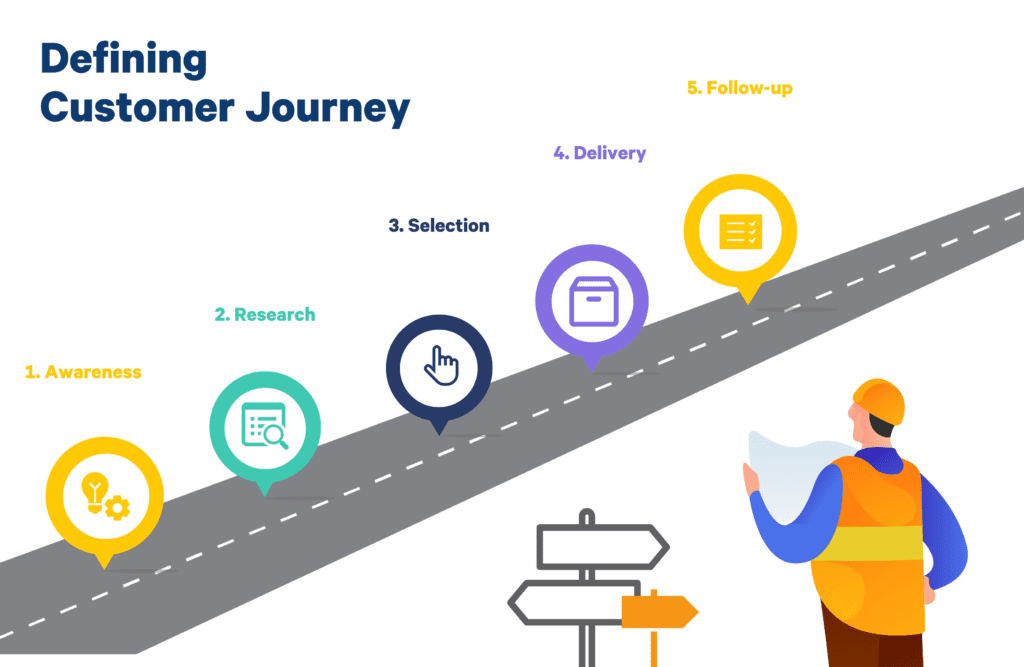
3. Choose the right distribution channel
What is the easiest way for your customers to reply? If they aren't tech-savvy, maybe you should send them a letter with a stamped return envelope to reach all target groups.
For most people, email or SMS work just fine.
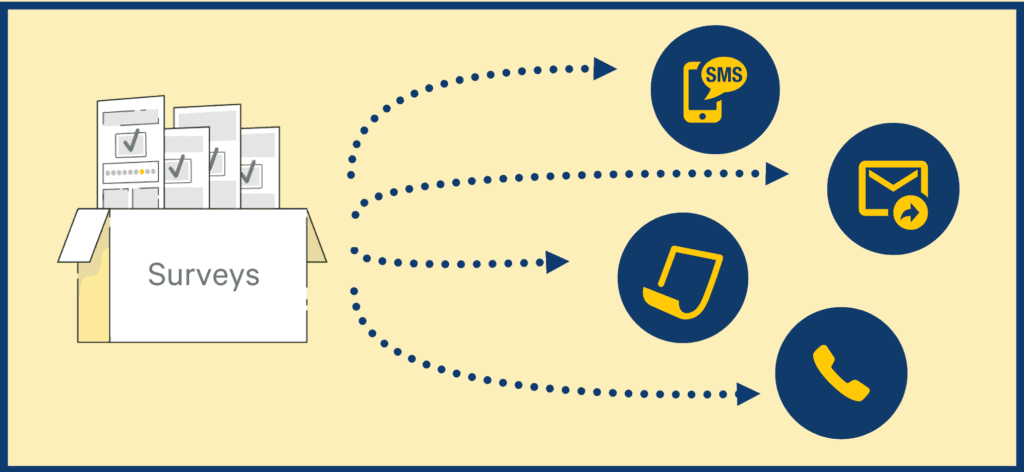
4. Timing is everything
The closer to an interaction you can send the survey to a customer, the more likely you are to get really useful insights on your operations. Emotional responses are at their highest when they've just had an experience with your brand. Try to make sure that the last impression you make is the most positive one.
The phenomenon is also called the peak-end rule.
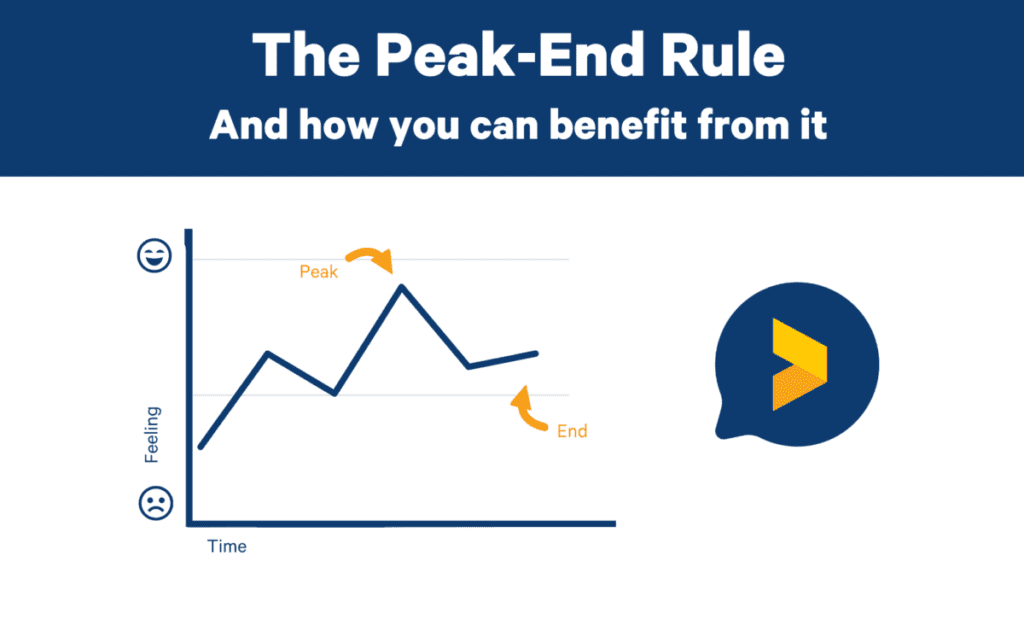
Tips for Great Survey Questions
Let's dive deeper into how to craft the best survey questions.
Make the survey easy to follow
People are bombarded with information these days. We’re constantly online now, connected to our smartphones and we have a host of sources vying for our attention.
With the latest news, social media posts, work emails, and staying up to date with friends, it can be very easy for a customer to simply ignore a customer survey when it lands in their inbox.
To avoid this you can:
- Keep the questions relevant to your objective - Don’t meander off onto other topics. If your survey is about a specific product and its features, don’t waste time on unrelated questions.
- Try to keep the survey focused on about 10 questions - Those longer than this tend to see their completion rates drop or the customer might get bored and just want to hurry through to the end which could skew your data.
- Tell your customers how long the survey will take - Customers are much more likely to respond if they know exactly how much time they’ll have to spend on the survey. Let them know in your initial contact with them.
Keep the questions short
- Use multiple choice questions as a useful tool - While open-ended questions can certainly have their uses, some customers are immediately put off answering a survey when they see a free text box. Keep things easy for them by providing a list of responses to choose from.
- Make responses simple with scores out of 10 - Another way to make things easy for the customer is an easy-to-follow score out of 10, providing quick and easy-to-read results.
- Always give customers an applicable answer - You should hopefully know why you’re targeting a specific customer or group of customers and have relevant answer options for them. Just in case though, give them an option to opt out of the question where it might not apply to them.
- Don’t lead the customer or use biased questions - This means avoiding questions like, “How much did you like our product” as this implies to the customer that they did like it and doesn’t give the option for honest feedback.
Add value to your customer
Surveys don’t have to be a one-way street where you take and the customer gives. When done correctly, a good survey can make the customer feel like they’ve contributed in some way, be this in product development or helping to give them better service next time.
While this might not always be possible (for example when trying to build new markets where customers don’t have any connection to you yet) always try and think about the value you can offer them when setting your survey objective.
Some ways to add value to the customer include:
- It gives the customer a chance to have a say in what they want - If a customer feels connected to a product they’re much more likely to respond to a survey. When offered the chance to give their thoughts on improvements, addition of new features or any other way in which they feel their voice is being heard, you’ll definitely up your response rate (and likely retain that customer).
- Try and follow up on surveys - If a customer has provided feedback in a survey that you subsequently went on to implement, try and follow up with that customer to let them know to show evidence that you listen to your customers. If you can show their responses had tangible results, there’s an excellent chance of you increasing customer loyalty.
- Offer incentives to complete the survey - People are taking time out of their busy days to complete a survey. If they don’t feel a connection with you or their product they may not respond at all. Try and incentivize customers with the chance to enter a prize draw for a voucher, or money off their next purchase as a way to encourage them to complete the survey.
Survey Question Types & How to Use Them
Now you know how to put together a good survey question and have a specific goal. Next up, we’ll run through some of the formats of questions and go over when to use them with some practical examples.
When using the examples below, try to stick to the same question type per survey. If you use many different types of questions within one survey, it can be a little confusing for the recipient.
Quantitative Survey Questions
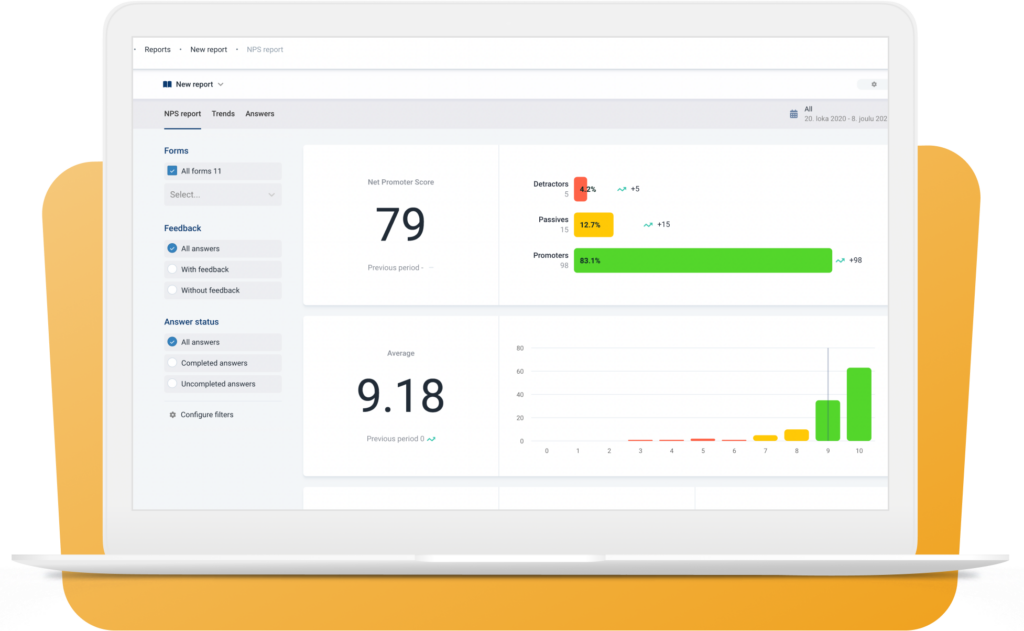
Quantitative survey questions are designed to collect numerical data that can be easily analyzed and used to identify patterns and trends.
These questions are essential for obtaining measurable and objective insights. However, they come with certain drawbacks.
Let’s explore some examples, their importance, and potential drawbacks.
Examples of Quantitative Survey Questions
- Demographic Questions:
- "How old are you?"
- "What is your annual income?"
- Frequency Questions:
- "How often do you visit our store? (Daily, Weekly, Monthly, Rarely)"
- "How many hours do you spend on social media per day?"
- Rating Scale Questions:
- Net Promoter Score: "On a scale of 1 to 10, how satisfied are you with our product?"
- Customer Satisfaction Score: "Rate your overall experience with our customer service (1 = Very Unsatisfied, 5 = Very Satisfied)."
- Customer effort score CES: "How easy was it to interact with us today (1 = Very difficult, 5 = Very easy)?"
- Multiple Choice Questions:
- "Which of the following products do you use? (Product A, Product B, Product C)"
- "What is your preferred method of contact? (Email, Phone, In-Person)"
- Yes/No Questions:
- "Do you own a smartphone? (Yes/No)"
- "Have you used our service in the past month? (Yes/No)"
- Ranking Questions:
- "Rank the following features in order of importance: price, quality, brand reputation, availability."
- "Rank the following activities based on how often you engage in them: Reading, Watching TV, Exercising, Socializing."
Importance of Quantitative Survey Questions
Quantitative questions provide concrete, numerical data that can be easily measured and analyzed. This makes it easier to track changes over time and make data-driven decisions.
These questions allow for the use of statistical tools to identify patterns, correlations, and trends. This helps in making informed predictions and understanding relationships between variables.
Quantitative data is less prone to bias than qualitative data. The responses are straightforward, reducing the influence of interpretation or personal bias in analysis.
Quantitative surveys can be administered to large populations, making it possible to generalize findings to a broader audience. This is particularly useful for market research and large-scale studies.
Drawbacks of Quantitative Survey Questions
Quantitative questions often fail to capture the depth and context behind a respondent’s answer. They do not provide insights into the "why" behind the data.
These questions are rigid and may not accommodate unexpected responses. Respondents may feel constrained by predefined answer choices.
Respondents might misunderstand the questions, leading to inaccurate data. Additionally, cultural differences can affect how questions are interpreted and answered.
Quantitative data provides surface-level insights but lacks the rich, detailed understanding that qualitative data offers. This can result in an incomplete picture of the respondent’s experiences or opinions.
Qualitative Survey Questions

Qualitative survey questions gather detailed, descriptive responses that provide deeper insights into the thoughts, feelings, and motivations of respondents.
These questions are crucial for understanding the context and nuances behind quantitative data.
However, they also come with certain drawbacks. Let’s explore some examples, their importance, and potential drawbacks.
Examples of Qualitative Survey Questions
- Open-Ended Questions:
- "What do you like most about our product?"
- "How can we improve our services?"
- Descriptive Questions:
- "Can you describe a recent positive experience you had with our customer service?"
- "Tell us about a challenge you faced while using our product."
- Opinion-Based Questions:
- "What are your thoughts on our new product design?"
- "How do you feel about the recent changes to our website?"
- Experience-Based Questions:
- "Can you share a memorable experience you had with our brand?"
- "What was your first impression of our product?"
- Why Questions:
- "Why did you choose our product over competitors?"
- "Why do you think our service meets or does not meet your expectations?"
Importance of Qualitative Survey Questions
Qualitative questions provide rich, detailed information that helps you understand the underlying reasons behind respondents' behaviors and attitudes. This depth of insight is often unattainable through quantitative questions alone.
These questions offer context to the quantitative data, helping you see the bigger picture. For example, knowing why customers are dissatisfied can be more valuable than simply knowing the number of dissatisfied customers.
By analyzing qualitative responses, you can identify common themes, patterns, and trends. This can lead to a better understanding of customer needs and potential areas for improvement.
Qualitative questions allow respondents to express their thoughts freely, providing insights that you might not have considered when designing the survey.
Drawbacks of Qualitative Survey Questions
Analyzing qualitative data is more time-consuming than quantitative data. Responses need to be read, categorized, and interpreted, which requires significant effort and expertise.
Qualitative data is inherently subjective and can be influenced by the respondents' personal biases and perspectives. This makes it harder to achieve consistency and objectivity in analysis.
While qualitative questions provide rich data, they are not as easily scalable as quantitative questions. Analyzing large volumes of qualitative responses can be challenging and resource-intensive.
Open-ended questions can sometimes lead to responses that are too lengthy or off-topic. This can make it difficult to extract useful information from the data.
Balancing Qualitative and Quantitative Questions
For a comprehensive understanding of your audience, it’s beneficial to combine qualitative and quantitative questions in your surveys.
This mixed-method approach allows you to gather both measurable data and in-depth insights, providing a more complete picture of your respondents' experiences and opinions.
Different Question Formats to Use in Surveys
Let's dive deeper into the formats in which questions are presented.
A good survey usually includes a mixture of multiple question formats and types.
Yet you have to carefully choose each question and reflect it with your goals.
1. Rating Scale or Likert Scale Questions
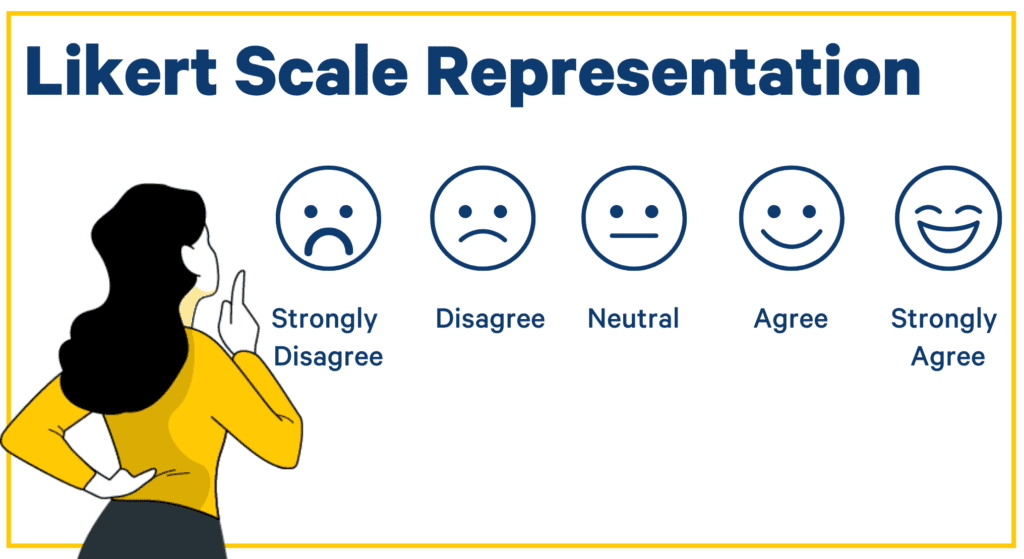
What are rating scale questions or ranking questions in surveys
Question types that use a likert scale are one of the simplest types of questions.
They usually ask the customer to rank something on a scale of 0-5, for example, with 5 being “Very satisfied” and 0 being “Not at all satisfied”. It is a type of close-ended question that limits a customer's choices.
When to use rating scale questions for surveys
Useful when you need quick, easy-to-read general statistics. For example, in assessing customer satisfaction on a new product launch or when gauging your net promoter score. They are also great to use when you don’t have a lot of time and resources to analyze surveys and need fast responses.
Examples of rating scale survey questions
- “How satisfied were you with the new features added to product X in June 20XX?”
- “How likely would you be to recommend product Y to your friends?”
- “How would you rate the overall quality of your buying experience?”
2. Multiple Choice Questions
What are multiple-choice survey questions?
These are a very popular choice of question type and offer the customer a number of different options to choose from, usually no more than five or six choices per question with a final option for “other” if none of the options are applicable to them.
Sometimes multiple-choice questions can be “dichotomous” offering only two options, or a simple yes/no response, while others are presented as a “Likert scale” that assesses a customer's level of agreement with a statement. All multiple choice questions are also a type of close-ended question where you have control over the responses.
When to use multiple-choice survey questions?
Similar to rating scale questions, these are great for providing easy-to-analyze statistics but in a little more depth. You can drill a little deeper into customer thoughts whilst at the same time controlling the data you’d like to collect, making it easier to analyze.
Examples of multiple-choice survey questions
- “Which of our products is your favorite?”:
- Product A
- Product B
- Product C
- Other
- How would you describe the level of customer service provided by our contact centre agent?”
- Excellent
- Good
- OK
- Poor
- Terrible
3. Open-ended Questions
What are open-ended survey questions?
Open-ended questions in surveys give you the freedom to ask whatever you’d like. There are no restrictions on customer responses and are given in the form of a free text box for them to fill in.
When to use open-ended survey questions
These are great when you want to learn about very specific customer needs as the customer is free to respond how they wish. They’re also useful in identifying a specific issue you have with a product or service. If you notice sales starting to fall, try reaching out to past customers to find out why they’re no longer interested in that product.
They are also a great addition to a quantitative question like NPS, as they shed light on why someone chose the specific rating.
However, you may find a lower response rate on open-ended questions given the additional time and effort you’re expecting from the customer to complete it.
Examples of open-ended survey questions
- “What made you choose to purchase product X”?
- “What specific product would you like to see us produce next and why?”
- “What made you decide to cancel your subscription with us?”
- “What are the biggest factors that prevent you from purchasing our product?”
- “If you could change one thing about our company, what would it be and why?”
Different Additional Question Types for Surveys
Let's go over some additional categories of survey questions that you can use, and why you should use them.
These questions are not the main point of your survey but they can help you segment survey data and make more educated decisions.
However, keep in mind that these questions add length to your survey. Therefore, consider carefully whether or not you really need them.
Demographic Questions in Surveys
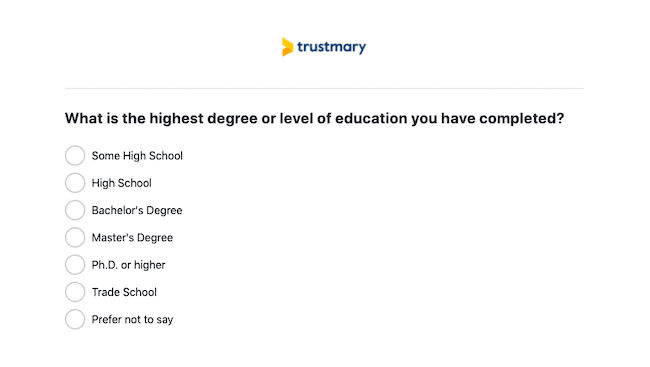
Demographic questions gather essential background information about respondents. Common demographic questions include:
- Age
- Gender
- Education level
- Income range
- Employment status
- Geographic location
These questions help in segmenting your audience and analyzing data trends across different groups.
Demographic questions are a critical component of any survey. They gather essential background information about respondents, helping researchers and organizations better understand and segment their audience. Let’s explore why these questions are so vital and how they can benefit your surveys.
Understanding Your Audience
Demographic questions help you paint a clearer picture of who your respondents are. By collecting data on age, gender, education level, income, employment status, and geographic location, you can:
- Identify Target Groups: Understand which demographic segments are most engaged with your product or service.
- Personalize Marketing Efforts: Tailor your marketing strategies to meet the specific needs and preferences of different groups.
- Improve Product Development: Develop products or services that cater to the unique characteristics and preferences of your target audience.
Enhancing Data Analysis
Demographic data allows for more detailed and meaningful analysis of survey results. You can:
- Segment Responses: Analyze responses by different demographic groups to uncover trends and insights that might be masked in aggregate data.
- Identify Trends: Spot patterns and trends within specific demographic segments, helping you make data-driven decisions.
- Compare Groups: Compare responses between different groups to understand how various factors influence opinions and behaviors.
Ensuring Representativeness
Demographic questions help ensure that your survey sample is representative of the broader population. This is crucial for:
- Accurate Results: Ensure that your findings reflect the views of the entire population you’re studying, not just a subset.
- Balanced Sampling: Identify and correct any imbalances in your sample, ensuring diverse perspectives are included.
- Valid Conclusions: Draw valid conclusions from your data, knowing that it accurately represents the target population.
Customizing Communication
Understanding the demographic makeup of your audience allows you to tailor your communication more effectively. This means:
- Relevant Messaging: Craft messages that resonate with different demographic groups.
- Effective Channels: Choose the right communication channels that each group prefers.
- Personalized Content: Provide content that speaks directly to the interests and needs of various segments.
Practical Applications
Here are a few practical applications of demographic questions in surveys:
- Market Research: Identify potential customer segments and understand their preferences.
- Employee Surveys: Analyze employee satisfaction and engagement across different departments, roles, and demographic groups.
- Customer Feedback: Understand how different customer segments perceive your product or service.
- Public Opinion Polls: Gather insights on how opinions and behaviors vary across different demographic groups.
Gender Questions on Surveys

Gender questions are demographic questions. Before deciding to include gender questions in your survey, consider carefully if it's needed. For example, does the respondent's gender really matter if you are looking for customer feedback?
However, in some cases, knowing the respondent's gender can be important. More so in medical or societal research, but also in market research.
When asking about gender, it’s important to be inclusive and respectful. Instead of a simple binary choice, provide options like:
- Male
- Female
- Non-binary
- Prefer not to say
- Other (with a space to specify)
This ensures that all respondents feel seen and respected.
Understanding Gender Differences
Gender questions help in identifying and analyzing differences in opinions, behaviors, and preferences between various gender groups. This can be particularly useful for:
- Product Development: Tailoring products or services to meet the unique needs of different gender groups.
- Marketing Strategies: Crafting marketing messages and campaigns that resonate with specific gender demographics.
- Customer Satisfaction: Understanding how satisfaction levels vary among different gender groups, leading to more personalized customer experiences.
Promoting Inclusivity and Representation
Asking about gender in a respectful and inclusive manner ensures that all respondents feel seen and valued. This is important for:
- Inclusivity: Providing options beyond the binary choices of male and female, such as non-binary, prefer not to say, and other, ensures inclusivity.
- Accurate Representation: Reflecting the true diversity of your audience by acknowledging and including gender identities beyond the traditional binary framework.
- Respectful Communication: Demonstrating respect for respondents' identities, which can improve the overall response rate and quality of feedback.
Enhancing Data Analysis
Gender data is crucial for detailed and insightful analysis. By segmenting responses based on gender, researchers can:
- Identify Trends: Spot trends and patterns specific to different gender groups.
- Compare Responses: Compare responses across gender groups to understand how gender influences opinions and behaviors.
- Address Disparities: Identify and address any disparities or biases that may exist between different gender groups.
Informing Policy and Decision-Making
Gender questions can provide valuable insights that inform policies and decisions. For instance:
- Workplace Policies: Creating policies that support gender diversity and equality in the workplace.
- Public Health Initiatives: Designing health programs that address specific needs and concerns of different gender groups.
- Educational Programs: Developing educational content and programs that are inclusive and equitable for all genders.
Practical Applications
Here are some practical ways gender questions can be used in surveys:
- Employee Surveys: Assessing workplace satisfaction and identifying any gender-specific issues that need to be addressed.
- Customer Feedback: Understanding how product usage and satisfaction vary among different gender groups.
- Market Research: Identifying target demographics and tailoring marketing strategies to specific gender groups.
- Public Opinion Polls: Gauging public opinion on various issues and understanding how these views differ across gender groups.
How to Ask Gender Questions
To ensure that gender questions are inclusive and respectful, consider the following tips:
- Provide Multiple Options: Include options beyond male and female, such as non-binary, prefer not to say, and other (with a space to specify).
- Use Inclusive Language: Avoid language that assumes a binary understanding of gender.
- Respect Privacy: Allow respondents the option to skip the question if they prefer not to disclose their gender.
Psychographic Questions in Surveys

Psychographic questions delve into the attitudes, interests, lifestyles, and values of respondents.
These questions are essential for gaining a deeper understanding of your audience beyond demographic data.
By including psychographic questions in surveys, businesses and researchers can uncover rich insights that drive better decision-making and more effective marketing strategies.
Understanding Customer Motivation
Psychographic questions help you understand the underlying motivations that drive customer behavior. This includes:
- Values and Beliefs: Discovering what matters most to your customers, such as sustainability, innovation, or community.
- Interests and Hobbies: Identifying what your customers are passionate about, from outdoor activities to technological gadgets.
- Lifestyle Choices: Understanding how customers spend their time and money, which can inform product development and marketing strategies.
Personalizing Marketing Efforts
By gaining insights into the psychographic profiles of your audience, you can create highly personalized marketing campaigns. This helps in:
- Segmenting Your Audience: Dividing your audience into distinct psychographic segments allows for more targeted marketing efforts.
- Crafting Relevant Messages: Developing messages that resonate deeply with each segment, addressing their specific needs and interests.
- Choosing Effective Channels: Identifying the best communication channels based on the lifestyle and preferences of different segments.
Enhancing Product Development
Psychographic data can guide product development by revealing what features and benefits resonate most with your target audience. This involves:
- Identifying Customer Pain Points: Understanding the challenges and problems your customers face in their daily lives.
- Aligning with Values: Ensuring that your products align with the values and lifestyle choices of your audience, which can boost brand loyalty.
- Innovating Based on Insights: Developing new features or entirely new products based on the deep understanding of customer motivations and preferences.
Improving Customer Experience
Psychographic questions can help you tailor the customer experience to meet the unique needs and preferences of different segments. This includes:
- Personalized Interactions: Offering personalized recommendations and interactions based on psychographic data.
- Enhancing Customer Service: Training customer service teams to understand and respond to the specific needs and concerns of different customer segments.
- Building Stronger Relationships: Creating deeper connections with customers by showing that you understand and care about their individual preferences and values.
Practical Applications
Here are some examples of psychographic questions you might include in a survey:
- Values and Beliefs: "How important is sustainability to you when choosing a product?"
- Lifestyle and Interests: "What activities do you enjoy in your free time?"
- Attitudes and Opinions: "How do you feel about the current trends in technology?"
- Personality Traits: "Would you describe yourself as an early adopter of new products?"
How to Implement Psychographic Questions
To effectively include psychographic questions in your surveys, consider the following tips:
- Be Clear and Specific: Ensure that questions are easy to understand and answer.
- Use a Mix of Question Types: Combine multiple-choice questions with open-ended questions to gather both quantitative and qualitative data.
- Respect Privacy: Be mindful of sensitive topics and respect respondent privacy, allowing them to skip questions if they prefer.
In summary
Remember, all good survey questions need a specific goal and everything should be geared towards improving the customer experience and creating a better product. Never just send out surveys for the sake of it. Think carefully about what you want to achieve but also feel free to experiment with the different types of questions listed above.
Monitor your response rates, find out what works for you and what types of questions are returning the most valuable responses and you’ll soon be producing highly targeted, specific and useful surveys.
Further Reading
- Create A Customer Satisfaction Survey: 11 Things to Consider
- 100+ Customer Satisfaction Survey Questions to Copy
- Design Surveys People Love to Answer
- Customer Surveys Are Dead – Try Trustmary Method
FAQ
What are some good questions for surveys?
Good questions depend completely on the goal of your survey. Generally speaking, it's good to include both quantitative and qualitative questions so that you can easily report numeric results and their development, but also gauge the sentiment behind the numbers.
For example, a good customer survey includes a scale or ranking question that measures satisfaction, and at least one open-ended question where they can tell you their reasoning behind the ranking. Additionally, it can include a couple of demographic questions if you want to be able to segment responses between different customer groups and profiles.
How many questions should a survey have?
Short answer: as few as possible. That way people are more likely to complete the survey and the response rate stays high.
You can manage with as little as 2 or 3 questions most of the time.
What is the difference between qualitative and quantitative question types?
Quantitative questions measure quantity and result in a numeric value you can measure and track. For example, scales and rankings are quantitative survey questions.
Qualitative questions, as you can see from the name, gauge the quality of something. With these questions, you can find out detailed descriptions on respondent's thoughts. They can be difficult to analyze, especially in scale, but they offer additional information that quantitative questions can't deliver.
When should I use demographic questions in surveys?
Demographic questions are useful when you want to be able to segment responses based on different demographic data, such as age, gender, location, or profession. Maybe you want to know if there is a difference in customer satisfaction between older and younger people, or you want to find out if there is a difference between how much men and women like your product.
Demographic questions like location and profession also become important when you ask for testimonials from your clients. They can add credibility to the testimonial.
Other than that, be careful with demographic questions. They might put people off and feel like an invasion of privacy, especially if they are mandatory questions.